“Sterling engine” solar collectors are a most ideal method for harnessing solar energy
by Edward Ulrich, updated September 18, 2022
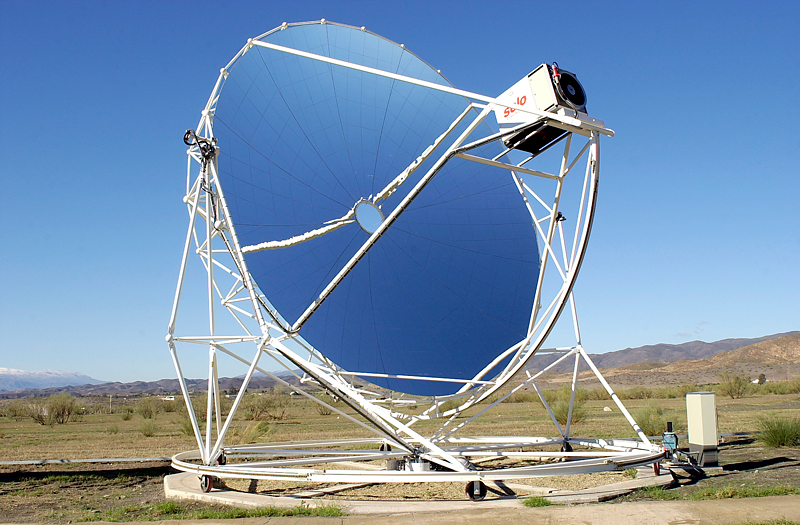
“Sterling engine” type solar power generators are the most efficient and inexpensive method for harnessing solar energy, and they have many benefits over centralized large scale solar installations that often cause serious harm to birds. A powerful personal solar power Sterling engine can easily supply all of the energy that is needed by a home. This article explains the mechanism of such devices and explains ideal potential implementations of them.
The most efficient and potentially cheapest method for generating solar energy is to use personal “Sterling engine” type solar power generators, which are simple mirrored dishes that focus light onto a central mechanical “Sterling engine” which is heated by concentrated sunlight to move pistons that generate electricity.
Sterling dishes can generate enough energy to supply an entire household using a dish that is small enough to fit onto the roof of the house, and the relatively small size of such dishes allows for netting to be utilized which would protect birds or any other animals from being harmed.
Article Notes
new:
September 18, 2022 - Added information about drawbacks of other types of solar technologies.
Jump to segments of this article ..
Solar Power Generating Sterling Engine Demonstration
The potential of concealing Sterling engine solar collectors with trellises
Drawbacks of large reflected-light solar plants that utilize a centralized solar collector
Drawbacks of flat solar panels
Why aren’t Sterling solar dishes being implemented on a larger scale?
Information from a Wikipedia article “Solar-powered Stirling engine”
Information about Sterling dish designs from a Wikipedia article “Solar thermal energy”
Other Images of Sterling Dishes
Information from a Wikipedia article about the National Solar Thermal Test Facility
The potential of concealing Sterling engine solar collectors with trellises
Drawbacks of large reflected-light solar plants that utilize a centralized solar collector
Drawbacks of flat solar panels
Why aren’t Sterling solar dishes being implemented on a larger scale?
Information from a Wikipedia article “Solar-powered Stirling engine”
Information about Sterling dish designs from a Wikipedia article “Solar thermal energy”
Other Images of Sterling Dishes
Information from a Wikipedia article about the National Solar Thermal Test Facility
Solar Power Generating Sterling Engine Demonstration
This video demonstrates a type of solar energy collector called a “Sterling Engine,” which is the most efficient way to generate electricity from the sun. It works by a reflective parabolic dish concentrating sunlight onto a hydrogen filled engine which contains a piston that is powered by the heat of the concentrated sunlight.
The potential of concealing Sterling engine solar collectors with trellises
An ideal solution would be to place as many dishes on a rooftop as possible, but a drawback to using dishes in such a manner is the fact that they would be very unsightly. However, such dishes could be almost entirely concealed using trellises that are covered with ivy or other materials.
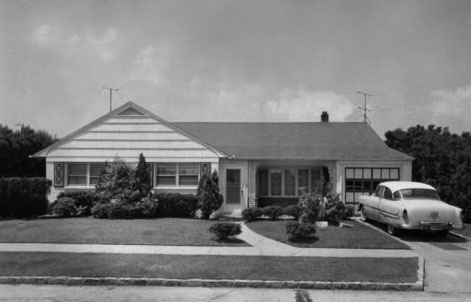
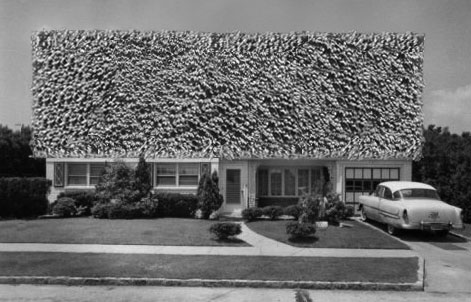
From the above images it is apparent that two large dishes would be able to fit onto the rooftop of many suburban houses without destroying the asthetic of the neighborhood. Surplus energy created by the dishes could potentially be supplied to adjacent houses and sold back to the utility company as well.
Solarhat.TV is a website I will be creating that will advocate for such solutions.
An ideal solution would be to place as many dishes on a rooftop as possible, but a drawback to using dishes in such a manner is the fact that they would be very unsightly. However, such dishes could be almost entirely concealed using trellises that are covered with ivy or other materials.


From the above images it is apparent that two large dishes would be able to fit onto the rooftop of many suburban houses without destroying the asthetic of the neighborhood. Surplus energy created by the dishes could potentially be supplied to adjacent houses and sold back to the utility company as well.
Solarhat.TV is a website I will be creating that will advocate for such solutions.
Drawbacks of large reflected-light solar plants that utilize a centralized solar collector
Centralized solar power plants run by utility companies such as The Ivanpah Solar Electric Generating Plant in California are usually not a viable solution due to the fact that they cause serious harm to birds, and their centralized nature usually locates them far away from where the energy is actually used, which results in massive amounts of energy being lost to resistance in the transmission wires. A much more effective solution is for solar energy to be generated and distributed as close as possible to the locations where the electricity will actually be used.
updated September 16, 2022
The wasteful and heavily government subsidized Ivanpah Solar Electric Generating Plant which opened in California’s Mojave desert in 2014 has brutally incinerated as many as 28,000 birds per year at the rate of ten per hour, but engineers are claiming that their efforts have supposedly reduced the amount of birds killed to two per hour. Nonetheless, even if the claim of the kills being reduced is true, it is still too many and the ineffective plant should be shut down.
Centralized solar power plants run by utility companies such as The Ivanpah Solar Electric Generating Plant in California are usually not a viable solution due to the fact that they cause serious harm to birds, and their centralized nature usually locates them far away from where the energy is actually used, which results in massive amounts of energy being lost to resistance in the transmission wires. A much more effective solution is for solar energy to be generated and distributed as close as possible to the locations where the electricity will actually be used.
Drawbacks of flat solar panels
Flat solar panels are only preferable when Sterling engines are not able to be used instead, for example on the rooftops of moving vehicles such as tractor-trailers and trains.
This Breitbart article explains that Amazon had powered down all of its solar rooftops in the U.S. after having problems with solar panels catching fire in at least six fulfillment centers.
The effectiveness of solar panels also decreases over time, with the panels usually being claimed to last no more than 25 years. Therefore in a few decades problems will arise due to them constantly needing to be disposed of.
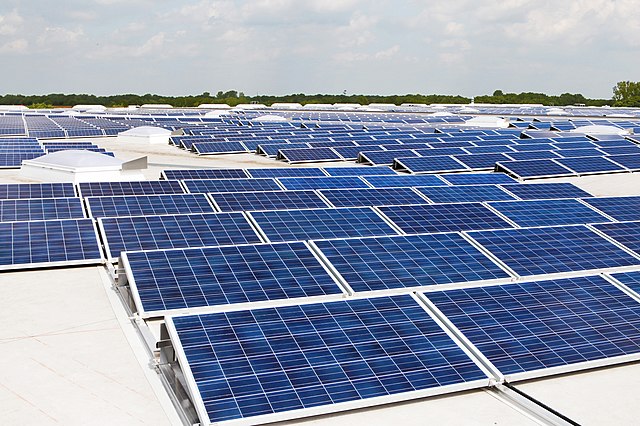
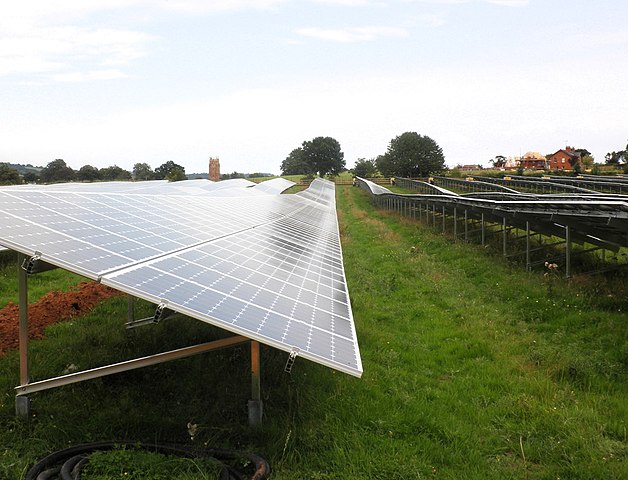
Flat solar panels are only preferable when Sterling engines are not able to be used instead, for example on the rooftops of moving vehicles such as tractor-trailers and trains.
This Breitbart article explains that Amazon had powered down all of its solar rooftops in the U.S. after having problems with solar panels catching fire in at least six fulfillment centers.
The effectiveness of solar panels also decreases over time, with the panels usually being claimed to last no more than 25 years. Therefore in a few decades problems will arise due to them constantly needing to be disposed of.

Image from Wikipedia.

Image from Wikipedia.
Why aren’t Sterling solar dishes being implemented on a larger scale?
The political Establishment knows how easy it would be for people to implement large personal Sterling engine type solar energy collectors, however for a number of reasons they are secretively opposed to people making use of that technology despite the fact that they claim to be worried about man-caused global warming.
The genuine motivations of the global elite with their supposed global warming concerns are actually entirely different than what people are led to believe when listening to the mainstream media. A close inspection of the “solutions” they are offering shows that they are using the issue for ulterior motives of consolidating their control over the nations and people of the world rather than for actually helping the environment. In fact, solid science shows that whatever global warming is occuring is a natural cyclical process that is not related to the amount of CO2 in the air.
The Sterling dishes are actually the exact opposite of everything the political Establishment is hoping to accomplish through their deception about climate change. The dishes would empower individuals to be self-sufficient and independent, which is precisely what the elite have been trying to eliminate through their legislation!
For that reason, the Establishment is not promoting or developing Sterling dishes in any significant way, even though such technology would be an excellent solution to their supposed “man-made climate change problem.”
See the following article directory for more information:
The political Establishment knows how easy it would be for people to implement large personal Sterling engine type solar energy collectors, however for a number of reasons they are secretively opposed to people making use of that technology despite the fact that they claim to be worried about man-caused global warming.
The genuine motivations of the global elite with their supposed global warming concerns are actually entirely different than what people are led to believe when listening to the mainstream media. A close inspection of the “solutions” they are offering shows that they are using the issue for ulterior motives of consolidating their control over the nations and people of the world rather than for actually helping the environment. In fact, solid science shows that whatever global warming is occuring is a natural cyclical process that is not related to the amount of CO2 in the air.
The Sterling dishes are actually the exact opposite of everything the political Establishment is hoping to accomplish through their deception about climate change. The dishes would empower individuals to be self-sufficient and independent, which is precisely what the elite have been trying to eliminate through their legislation!
For that reason, the Establishment is not promoting or developing Sterling dishes in any significant way, even though such technology would be an excellent solution to their supposed “man-made climate change problem.”
See the following article directory for more information:
updated October 14, 2022
This section directory contains articles examining treaties and legislation associated with climate change such as the Kyoto Protocol, “Cap and Trade” legislation, and the 2009 “Framework Convention on Climate Change.” It is shown that the implementation of such measures are meant to further long-range objectives of global elite individuals and organizations such as the United Nations, while actually having little or nothing to do with helping the environment.
Information from a Wikipedia article “Solar-powered Stirling engine”
Following is from this Wikipedia article:
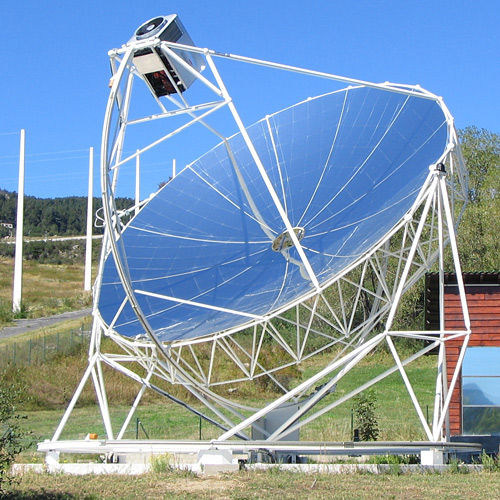
A 10 kW Dish-Stirling system in Font-Romeu-Odeillo, France. Image from Wikipedia.
A solar powered Stirling engine is a heat engine powered by a temperature gradient generated by the sun. It was patented by Roelf J. Meijer in 1987. His invention combines a heat engine, such as a Stirling cycle engine, with a solar dish collector to produce electricity. [Editor’s Note— See this link for a PDF of the patent on the NASA website. In the "background" section of the first page it explains that Sterling engines were being developed for Ford Motor Company starting in 1972, however apparently it was not initially for solar applications.] This apparatus consists of a large dish that concentrates solar energy to a focal point at the center of the dish. The concentrated solar energy drives Stirling cycle engine, which operates by letting heat flow from a hot source to a cold sink to do work. The work output of the Stirling cycle then drives a generator to create electric power. Moreover, for optimal heat collection, Meijer’s solar-powered engine requires that the dish always point directly at the sun so no shadows are in the solar dish collector. This presented issues because, for the apparatus to have a complete range of motion, lubrication and rotational systems are necessary, and may compromise structural stability.
NASA patented a second type of solar-powered Stirling engine on August 3, 1976. [Note— I don't know why they are referring to it as “second” type since it was patented first.] It used solar energy to pump water from a river, lake, or stream. The purpose of this apparatus is to “provide a low-cost, low-technology pump having particular utility in irrigation systems employed in underdeveloped arid regions of the earth...[using] the basic principles of the Stirling heat engine.
Around 2010, a company called Sunvention Solar Energy created a device similar to the NASA design that they say can pump 100,000 gallons per day, purely off of solar energy and the Stirling cycle, and costing only US$1,250. This apparatus, much like the others, uses a large solar dish to collect heat from the sun to create a high temperature source, and also uses low temperature water from a nearby stream as its low temperature source. This provides a great temperature range, which in turn provides more power. The work in Sunvention’s apparatus pumps the water into nearby crop fields, providing a “low-cost, low-technology pump having particular utility in irrigation systems employed in underdeveloped arid regions of the earth.”
Information about Sterling dish designs from a Wikipedia article “Solar thermal energy”
Following is from this Wikipedia article:
CSP-Stirling is known to have the highest efficiency of all solar technologies (around 30%, compared to solar photovoltaic’s approximately 15%), and is predicted to be able to produce the cheapest energy among all renewable energy sources in high-scale production and hot areas, semi-deserts, etc. A dish Stirling system uses a large, reflective, parabolic dish (similar in shape to a satellite television dish). It focuses all the sunlight that strikes the dish up onto a single point above the dish, where a receiver captures the heat and transforms it into a useful form. Typically the dish is coupled with a Stirling engine in a Dish-Stirling System, but also sometimes a steam engine is used. These create rotational kinetic energy that can be converted to electricity using an electric generator.
In 2005 Southern California Edison announced an agreement to purchase solar powered Stirling engines from Stirling Energy Systems over a twenty-year period and in quantities (20,000 units) sufficient to generate 500 megawatts of electricity. In January 2010, Stirling Energy Systems and Tessera Solar commissioned the first demonstration 1.5-megawatt power plant (“Maricopa Solar”) using Stirling technology in Peoria, Arizona. At the beginning of 2011 Stirling Energy’s development arm, Tessera Solar, sold off its two large projects, the 709 MW Imperial project and the 850 MW Calico project to AES Solar and K.Road, respectively. In 2012 the Maricopa plant was bought and dismantled by United Sun Systems. United Sun Systems released a new generation system, based on a V-shaped Stirling engine and a peak production of 33 kW. ...
According to its developer, Rispasso Energy, a Swedish firm, in 2015 its Dish Sterling system being tested in the Kalahari Desert in South Africa showed 34% efficiency.
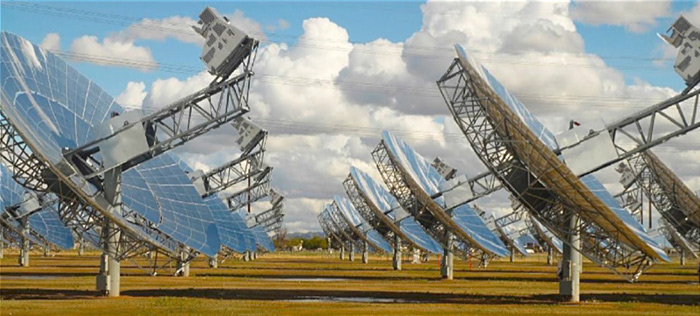
At the United Sun Systems Maricopa dish-Stirling plant in Phoenix, Arizona. Image from Wikipedia
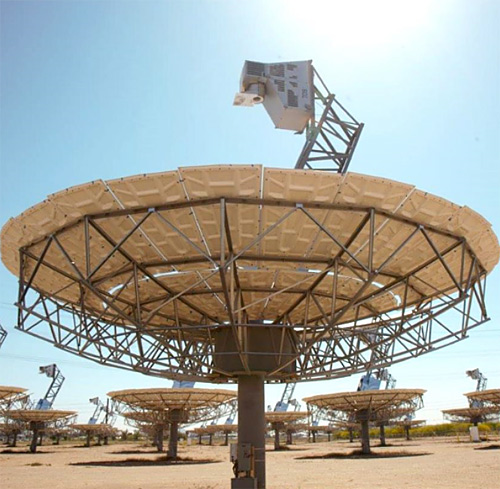
At the United Sun Systems Maricopa dish-Stirling plant in Phoenix, Arizona. Image from Wikipedia.
Other Images of Sterling Dishes
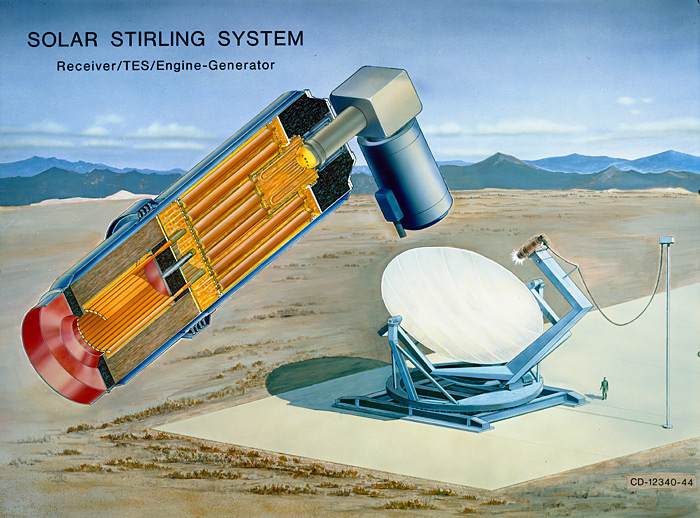
A 1979 NASA drawing of a solar sterling engine. Image from Wikipedia.

Several rows of solar dishes point toward the sun July 2, 2013, at Tooele Army Depot in Utah, part of a $9.6 million dollar project managed by the U.S. Army Corps of Engineers Sacramento District. The project, which includes the placement of more than 420 solar dishes on 3.5 acres, will provide the installation with 1.5 megawatts of energy once complete - enough to power 300 to 400 homes. Each solar dish is a mirrored, parabolic dish which reflects and focuses the heat from the sun onto a Stirling engine to generate electricity. Image from Wikipedia.
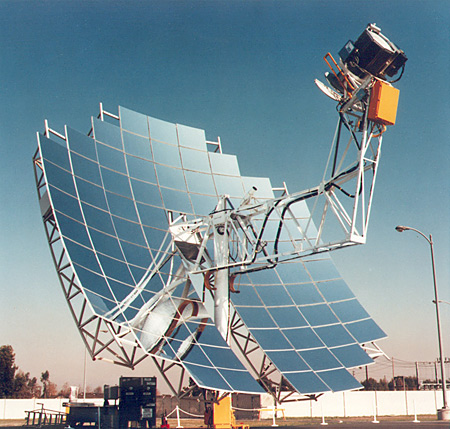
A parabolic solar dish concentrating the sun’s rays on the heating element of a Stirling engine. The entire unit acts as a solar tracker. Image from Wikipedia.
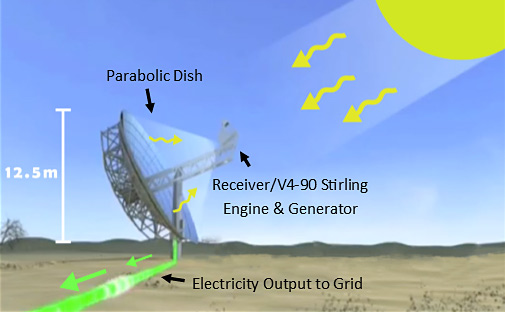
An illustration of the principle of a solar parabolic dish. Image from Wikipedia.

A solar sterling engine dish in Almeria, Spain. Image from Wikipedia.
Information from a Wikipedia article about the National Solar Thermal Test Facility
Following is from this Wikipedia article:
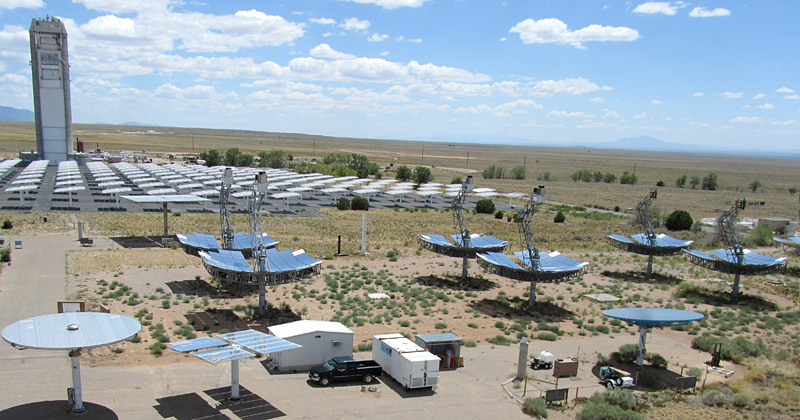
Sterling dishes at the National Solar Thermal Test Facility (NSTTF) in Albuquerque, New Mexico. Image from Wikipedia.
Operated by Sandia National Laboratories for the U.S. Department of Energy (DOE), the National Solar Thermal Test Facility (NSTTF) [in Albuquerque, New Mexico] is the only test facility of this type in the United States. The NSTTF’s primary goal is to provide experimental engineering data for the design, construction, and operation of unique components and systems in proposed solar thermal electrical plants planned for large-scale power generation.
The site was built and instrumented to provide test facilities for a variety of solar and non-solar applications. ...
History
.. The United States government initiated support [for the facility] through the National Science Foundation Research Applied to National Needs (RANN) program in 1972 which was eventually funded by the Energy Research and Development Administration and the Department of Energy. Six central receiver pilot plants were constructed including the 5 MW (thermal) test facility at Sandia National Laboratories.
...
[Note the article also contains information about the facility’s heliostat field, solar tower, and molten salt test loop, however I have not included information about those due to such installations being very harmful to birds.]
...
Dish test facility
This area of the site allows industry partners to install full-scale solar dishes for long-term reliability testing and evaluation. There are currently ten dishes from Stirling Energy Systems and six Infinia dishes at this location. The site also includes two SNL-developed solar dishes that are available for research. ...























